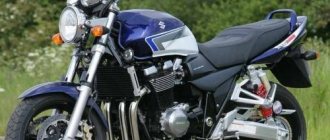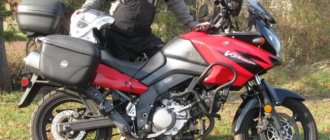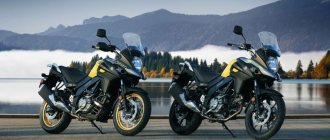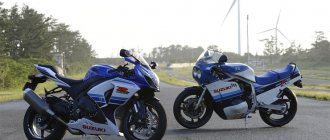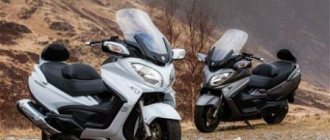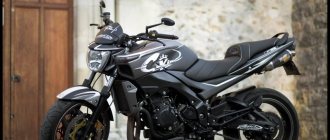GSX1400
One of the world's largest "neo-classics" Suzuki GSX1400 received an in-line four-cylinder engine, which is equipped with a fuel injection system with dual throttle valves and a vibration-reducing balance shaft. The working surface of the engine cylinders is covered with a special metal-ceramic composition. Suzuki GSX1400 front brake discs have six-piston calipers. The frame is steel duplex, the suspensions have a full range of adjustments. Suzuki launched the GSX1400 in 2001, recognizing the growing popularity of large-displacement fairingless motorcycles. The powerful GSX1400 engine traces its roots back to the GSX1100 from the 1980s. The prototype for it was the motors used on the GSX1100, GSX-R1100 and GSF1200 Bandit models. However, unlike the carbureted power system, the GSX1400 has an SDTV (Suzuki Dual Throttle Valve) fuel injection system (like the latest GSX-R series sports models). Due to Euro III regulations in Europe, 2006 marks the last year the GSX1400 will be available in Europe. GSX1400 2002 Suzuki year code: K2 – Suzuki introduced the most powerful muscle bike in the lineup in March 2001 and was designated K1. Originally not intended for export to the USA and Europe. Initially, the GSX1400 was only available in Japan and had a power limit of 100 hp. (75 kW) and speed of 180 km/h. The motorcycle arrived in Europe without restrictions. The engine build is more reminiscent of the GSX-R1000 than the 1980 GSX1100E. The braking system is also similar to that of the TL1000R and GSX-R1000. Available colors: Pearl Deep Blue / Pearl Still White (L99), Metallic Galaxy Blue (YM2) and Candy Grand Blue (YC2) GSX1400 2003 Suzuki year code: K3 – The GSX1400 received a new livery, but remained without technical innovations. Available colors: Pearl Deep Blue / Pearl Still White (L99) and Sonic Silver Metallic (YD8) GSX1400 2004 Suzuki year code: K4 - new graphics on gas tank and tail. Release of the “special” GSX1400 Data with a computer chip in the suspension, shown at the Tokyo Motor Show in October 2003. Available colors GSX1400 K4: Pearl Deep Blue / Pearl White (LR5), Pearl Red / Solid Black (CG9), Solid Black (GSX1400 Data) GSX1400 2005 Suzuki year code: K5 – The exhaust system has changed: instead of the 4-2-2 type, a 4-2-1 is installed. Updated injector, special Suzuki Composite Electrochemical Material (SMEC) cylinder coating. The front brake now has 5 adjustment positions instead of six. Changed the Suzuki logo to a single S. Available colors: Pearl Deep Blue / Pearl White (LR5), Pearl Red / Solid Black (CG9), Solid Black (B PJ) GSX1400 2006 Suzuki year code: K6 – some changes in the tail section of the motorcycle, as well as a new color scheme. GSX1400 2007 Suzuki Yea
Material details
- Model GSX1400 2002-2008
- Brand Suzuki
- Country of origin: Japan
- Model year 2006
- Motorcycle class Road
- Engine type 4 cylinders, in-line, 4-stroke, DOHC
- Number of cylinders 4
- Number of measures 4
- Ignition / Starting Electronic / electric starter
- Engine capacity, cm3 1402
- Compression ratio 9.5:1
- DOHC gas distribution system
- Valves per cylinder 4
- Cooling system Air-oil
- Cylinder diameter and piston stroke, mm 81 x 68
- Power, kW/hp @ rpm 79 / 106 @ 6500
- Torque, Nm @ rpm 125 @ 5,000
- Clutch Multi-disc, oil bath
- Lubrication system Oil bath crankcase
- Maximum speed, km/h 241
- Fuel tank volume, l 22
- Type 6-speed
- Number of gears 6
- Duplex frame, made of steel pipes
- Front suspension Telescopic cartridge fork with pipes with a diameter of 46 mm, with a full range of adjustments
- Front suspension travel 130
- Rear suspension Pendulum, two shock absorbers
- Rear suspension travel 123
- Front brakes Hydraulic; two disks
- Rear brakes Hydraulic; disk
- Drive chain
- Wheelbase, mm 1520
- Seat height, mm 790
- Ground clearance, mm 130
- Front tires 120/70-ZR-17
- Rear tires 190/50-ZR-17
- Length, mm 2 160
- Width, mm 810
- Height, mm 1 140
- Dry weight, kg 226
- Number of seats 2
- Price 340,000 rubles
- Available GSX1400 colors: Blue/White, Solid Black
Hello everyone! That's it, I figured out all the major and significant classics of Japan that are relatively accessible to us mere mortals. And the last one was the thickest in terms of engine, the GSX 1400. For those far from the topic, let me explain, PYCH (as it is usually called for convenience), is a big classic from the 2000s, which had an air-oil engine with a capacity of 1405 cm3. Those. can easily compete in this indicator with some basic Solaris from our time. At the same time, it is not forced to the limit, but on the contrary, it is configured for good traction throughout the entire range and has the same Solaris 100-106 hp. at 7000 rpm, and 126 nm at 5000 rpm (I’m writing from memory). And all this equipment is contained in a motorcycle weighing about 250 kg.
Let's start in order; when it appeared in 2001, the moto was very technologically advanced and progressive. He was the first to receive an injector (and with two valves at once, if I’m not mistaken), received 6 gears, 46! fork, brakes like those of the beads of those years, and so on. It would seem that he should have captured the market, but it turned out differently. It did not become a sales leader, and already in 2008 it was discontinued on the pretext of poor ecology, although the much simpler XJR lasted until the 17th, and for a classic, 7-8 years is not a very long time.
It’s difficult for me to judge why this happened, but it is clear that the main reason was the market and demand. The model would of course be updated, but apparently the demand was not enough for this. I suppose that the main reason for this outcome was the design of the device (it was too modern, although not bad at all) and its “refinement”.
Well, now briefly about the impressions this motorcycle gives in motion (I’ll try to tell you more about what I didn’t voice in the video for one reason or another). First and foremost, the spendthrift is very similar to a bandit. Not in terms of the engine, first of all, but in terms of the chassis. At low speeds it is light and obedient (within the class, 250 kg will not disappear anywhere of course), at high speeds it is somewhat straightforward when cornering (perhaps this is also due to the 190 rear wheel). At the same time, the chassis feels dense; the efforts with the huge fork were clearly not in vain. The brakes are quite sufficient for him if they are in good condition. The engine is where the most interesting thing is. First, it is very smooth. Secondly, the gear ratio in the first two gears is specially stretched. To understand, at 9000 maximum revolutions, it goes up to 100 km/h (I didn’t look closely in the video) in first gear and up to 160 in second (according to the speedometer). The same speedster at 100 km/h already has about 10,000 rpm, and at about 160 it is already in 3rd with only 5 gears. As a result, when accelerating on the PYCH, a very strange “trolleybus” feeling arises, especially if you turn it up on the second one from 20 to 160. At the same time, we carried out several races and found out that even with the first two being so elongated, the motorist can easily argue with the HYZH, but the emotions from overclocking are somewhat different here and there. It is obvious that this motor has a lot of potential. It’s enough just to put a larger sprocket back, and it will probably get away from the hunter, let alone fine-tuning the huge engine. Although, judging by the forum, there is some kind of 8-bit brain, which is not so easy to flash, and changing is not very expensive. But this is already a lyric, the mot is good in stock.
Well, that's all for now, you can watch the rest in the video.
Interesting news on the topic
Suzuki Jimny turned into a truck for return to Europe
In Europe, the commercial Suzuki Jimny does not have a second row of seats - instead, the car has a flat floor September 10, 2020
Suzuki Jimny died the death of tuning
Tuning is a scary business, especially when it is applied to unsuitable cars, such as SUVs. Now we do not mean preparation for serious off-roading, but something strange like understatement August 12, 2020
Suzuki Jimny leaves Europe
Very soon this charismatic car will leave the Old World. It's all about tightening environmental requirements July 09, 2020
Suzuki introduced a new crossover - it's Toyota
Suzuki has announced the premiere of the compact crossover Across. The novelty is a new Toyota RAV4 with a slightly rethought appearance July 02, 2020
Suzuki Swift updated
The fourth generation Suzuki Swift appeared at the very end of 2016. In the fifth year of life of the compact hatch, the Japanese brand carried out a small modernization of it May 20, 2020
Suzuki Jimny will be a five-door
Suzuki may launch a five-door Jimny that will be produced and sold in India, Autocar India has learned. This version will receive an extended wheelbase and two additional doors, as well as a larger trunk April 01, 2020
Suzuki Corporation celebrated its centenary
Just a few days ago, the Japanese corporation celebrated its centenary and it should be noted that despite the whole sad picture of the world, the corporation is preparing to conquer new heights March 27, 2020
Suzuki will build a new plant despite the virus
In difficult times for the whole world, many manufacturers have stopped automobile factories. Meanwhile, Suzuki is going to build a new factory. It will be located in Myanmar on March 25, 2020
Motorcycle Suzuki GSX 1400 Final Edition 2006 review
The description of the Suzuki GSX 1400 Final Edition 2006 motorcycle is in the queue for publication of the article. Announcement: Today, for almost every new motorcycle that comes into being, marketers strive to carve out their own niche. This one is a road sport, this one is a recreational enduro. But what class should we include a motorcycle that has a little bit of everything? A good bike should have a reliable engine, comfortable ergonomics and simple controls...
Suzuki GSX 1400 Final Edition is a motorcycle not sold in Russia, equipped with a fairly high-power engine of 106.0 hp. Despite the fact that good models of motorcycles have a very respectable price, and the season for their use is relatively short, the motorcycle market is developing rapidly. And if you believe the words of dealers, then some models of recently released motorcycles are selling like hot cakes at the beginning of the season, and the models brought to Russia are clearly not enough to fully satisfy consumer demand.
A motorcycle has long ceased to be an alternative to a car, and the times when this equipment was bought only because there was not enough money for a full-fledged car are forgotten. Nowadays, two-wheelers can be called technological marvels in many cases, and their cost can be compared with that of prestigious cars.
Many people have started buying motorcycles for hobby purposes as riding or even collecting them has become a good pastime for many people. Many motorcycles, for example the Suzuki GSX 1400 Final Edition, whose technical characteristics allow the model to be called a prestigious brand, are in demand among both beginners and experienced motorcyclists.
Motorcycles with an engine capacity of 1402 cc. see, appeared as a result of long work of inventors who sought to create a model that was not inferior in characteristics to other versions of the motorcycle. In some cases, these models are not only not inferior, but also ahead of other motorcycles, as they have minimal fuel consumption and other excellent parameters.
Motorcycles with an engine capacity of more than 400 kb. cm, which includes the Suzuki GSX 1400 Final Edition - this category of motorcycles simply cannot claim the title of “motorcycle for a beginner.” On the contrary, this is already a serious technique that requires certain control of motorcycle equipment with a smaller engine capacity. Yes, she attracts more attention, she is the most beautiful, fast, interesting and there is a huge selection of models. But as power increases, the weight of the motorcycle inevitably increases. In this class you are unlikely to find motorcycles lighter than 180 kg, unless they are the latest motorcycle models.
Go to the entire range of Suzuki motorcycles, on this page you can find Suzuki GSX 1400 Final Edition motorcycles from other years of production and information about them
Suzuki GSX1400: Test drive from Motorreview
To be honest, 1200 cc for the Suzuki Bandit always seemed to me to be a borderline value, beyond which comes not so much the process of piloting a motorcycle, but the struggle with the curb weight, which is very close to the 300 kg mark. Many people mistake the Suzuki GSX1400 for an enlarged copy of the Suzuki Bandit 1200 , but the very first seconds of communicating with this motorcycle convinced me that this is not the case at all. If you look at things more or less soberly (I said more or less!), then even the Bandit series quite conventionally lives up to its brutal name.
And our patient, it seems, did not leave McDonald’s at all, eventually growing a very decent size “mamon”. And what are the muffler pipes! The dream of any street racer, who is ready to do anything for the sake of such beauties, except turn on common sense in his stupid head.
However, the main component, which is an indispensable condition for a true “machocycle,” should certainly be recognized as an engine of infinite size, immodestly protruding with overgrown sides of the crankcase on both sides of the motorcycle, like the cheeks of a just-eaten hamster. Tuning in the form of protective bars is strictly required!
As soon as you sit down on the wide and comfortable seat, you immediately begin to understand very well the true weight and size of the device. Despite the fact that the seat height is only 800 mm, the Suzuki GSX1400 is still not perceived as small in height. This is, first of all, due to its width, which is slightly higher than the threshold of feeling for a motorcycle, when you can wrap your legs around it on both sides and thus understand all the nuances of behavior on the road. This is not the case here; it’s more about the fact that you’re just sitting on top of a very decent-sized device, nothing more. In general, everything is the same as in the good old 80s or 70s, absolutely no difference. Except that such an engine capacity, at least on production motorcycles, did not exist in those days. But how will a tall owner feel good behind the wheel - plenty of space and plenty of space both in the legs and along the length of the seat (which your passenger will appreciate), everything is very comfortable.
Only the blind will not see the classic cutlery glasses. The information content of the dashboard is exemplary. At the same time, a pilot of average height is also unlikely to have the thought of complaining about anything - the ergonomics have been verified. Everyone will feel comfortable here. The main thing to remember is that at low speeds or in parking mode, the considerable weight of the motorcycle absolutely does not disappear anywhere and makes itself felt very clearly.
Once you start the engine, you immediately begin to understand why there is such a volume. No motorcycle analogies - just the ordinary operation of a car engine. Everything is very smooth and quiet. Absolutely no vibrations; we should not forget that the engine is air-oil cooled and does not have a water jacket!
And now the main thing: the “trick” for which, in fact, all this was “stirred up”. With virtually equivalent torque to a small diesel truck, you can easily get going in second gear. Or even the third! In motion, this means that the engine does not care at all what gearbox stage you are in at the moment; they generally seem to be present here solely because it is customary, and you still need to save fuel.
As soon as I accelerated the “behemoth” a little, the problem of the heavy weight almost ceased to bother me. I won’t say, of course, that the motorcycle began to steer like a Suzuki GSX-R1000 , but life has become much easier. By and large, after driving 50 kilometers, I stopped worrying about this topic altogether, pushing through dense traffic almost at the speed of my Suzuki TL1000R . True, with very active maneuvering, relatively long-travel suspensions make themselves felt. First of all, designed for comfort. The large “Sousa” begins to sway unhappily, increasing the dynamic corridor and slightly straightening the intended trajectory.
Well, to Caesar is Caesar's. After a series of vigorous decelerations from speeds of 200 km/h and above, the brakes “get tired” quite quickly, which is quite natural, given the weight of the motorcycle. It was also interesting to note that despite the almost complete absence of at least some wind protection up to 200 km/h, the situation is more or less tolerable. In any case, much better than one might expect. The “picture” in the rear-view mirrors does not vibrate, and they themselves do not show parts of your body, which many compact motorcycles like to do, but the road situation behind you.
But the hooligan abilities of the motorcycle seriously disappointed me! It seemed that with such volume and torque, the Suza should jump onto the rear wheel from second gear almost easier than many motorcycles simply starting off. Alas, as they say, “nicht vobla!!!” And this despite the fact that the Suzuki Bandit 1200 performed this action quite easily. I can’t say for sure what the problem is here. The weight of the devices differs very slightly... Perhaps, for the sake of the environment, the designers seriously strangled the engine thanks to the injector? Perhaps it’s a matter of a different weight distribution and different gear ratios... Be that as it may, the unsightly fact for the Susa remains: the less cubic capacity and torque Bandit has much greater potential for a wheelie!
Having reached the karting track and anticipating a possible trouble in advance, I changed the footrest stops to specially “trained” ones, prepared for slaughter. However, I was so carried away by the slopes that I didn’t notice how I was completely knocking them off, eventually damaging the footrests too! In this regard, I would like to note two important aspects. Firstly, for such a mass and size, the handling of the motorcycle should be considered simply refined. I would never have thought that this Susa would allow me such angles of inclination, while remaining surprisingly stable and obedient. And the second point is that the footrests are simply indecently low and come into contact with the surface too early. However, maybe I’m going a little overboard here, because on a normal road it’s probably not worth driving with such inclination angles.
By the way, about ordinary roads. On the way back, in a relatively empty area, the device quite briskly accelerated to 240 km/h according to the speedometer, however, maintaining this mode for more than 30 seconds seems to be an unrealistic task, health is not enough. It is impossible not to mention the 22-liter gas tank. If you maintain a relatively reasonable speed limit, say, up to 160 kilometers per hour, then you can count on a 250-300 kilometer power reserve.
And the 1400 cc Suza is perfect for tourism. In general, as for the practical side of using this motorcycle as a vehicle, everything is just wonderful. Under the seat there is a decent-sized container, which, for example, includes a large U-shaped lock for the rear wheel, while still leaving room for, say, a rain cover. The absence of expensive plastic greatly simplifies the process of recovery from falls; you just need to remember about the mandatory protection of the engine. The relaxed seating position, coupled with a huge and comfortable seat, will not allow either the pilot or his passenger to get tired, and the “endless” engine will not bother you with the need for frequent switching.
Summing up the whole bouquet of impressions received from the riding day, we get a real classic motorcycle. Convenient for almost any life situation. Be it daily movement along the route home - work - home or a long-awaited trip together with a charming passenger.
However, where have you seen a barrel of honey without a huge bear on duty next to it? Having added another 200 cc in volume compared to its 1200 cc criminal relative, the Suzuki GSX1400 has lost a fair amount of sportiness. However, maybe he doesn’t really need this?
Go to Suzuki GSX 1400
- Read review Suzuki GSX 1400
Brief history of the model
Model
: Suzuki GSX-R600 (Europe, North America, Australia).
Factory designation
: GSX-R600V.
Model
: Suzuki GSX-R600 (Europe, North America, Australia).
Factory designation
: GSX-R600W.
Model
: Suzuki GSX-R600 (Europe, North America, Australia).
Factory designation
: GSX-R600X.
Model
: Suzuki GSX-R600 (Europe, North America, Australia).
Factory designation
: GSX-R600Y.
Model
: Suzuki GSX-R600 (Europe, North America, Australia).
Factory designation
: GSX-R600K1.
Model
: Suzuki GSX-R600 (Europe, North America, Australia).
Factory designation
: GSX-R600K2.
Model
: Suzuki GSX-R600 (Europe, North America, Australia).
Factory designation
: GSX-R600K3.
Model
: Suzuki GSX-R600 (Europe, North America, Australia).
Factory designation
: GSX-R600K4.
Model
: Suzuki GSX-R600 (Europe, North America, Australia).
Factory designation
: GSX-R600K5.
Model
: Suzuki GSX-R600 (Europe, North America, Australia).
Factory designation
: GSX-R600K6.
Model
: Suzuki GSX-R600 (Europe, North America, Australia).
Factory designation
: GSX-R600K7.
Model
: Suzuki GSX-R600 (Europe, North America, Australia).
Factory designation
: GSX-R600K8.
Model
: Suzuki GSX-R600 (Europe, North America, Australia).
Factory designation
: GSX-R600K9.
Model
: Suzuki GSX-R600 (Europe, North America, Australia).
Factory designation
: GSX-R600L0.
Model
: Suzuki GSX-R600 (Europe, North America, Australia).
Factory designation
: GSX-R600L1.
Model
: Suzuki GSX-R600 (Europe, North America, Australia).
Factory designation
: GSX-R600L2.
Model
: Suzuki GSX-R600 (Europe, North America, Australia).
Factory designation
: GSX-R600L3.
Model
: Suzuki GSX-R600 (Europe, North America, Australia).
Factory designation
: GSX-R600L4.
Model
: Suzuki GSX-R600 (Europe, North America, Australia).
Factory designation
: GSX-R600L5.
Model
: Suzuki GSX-R600 (Europe, North America, Australia).
Factory designation
: GSX-R600L6.
Model
: Suzuki GSX-R600 (Europe, North America, Australia).
Factory designation
: GSX-R600L7.
Model
: Suzuki GSX-R600 (Europe, North America, Australia).
Factory designation
: GSX-R600L8.
Model
: Suzuki GSX-R600 (North America, Australia).
Factory designation
: GSX-R600L9.
Model
: Suzuki GSX-R600 (North America, Australia).
Factory designation
: GSX-R600M0.
Video
Classic motorcycle Suzuki GSX 1400
- a bright representative of cubature “classics”. The numbers in its name clearly hint at the impressive engine capacity, as well as the fact that without solid driving experience behind you, you shouldn’t get on it - it’s dangerous. This bike was produced from 2001 to 2008, and although it is very similar to the famous “Bandits” line, it stands apart from it. However, there are some similarities with the Suzuki GSF 1200 in its naked version.
The similarity with the “Bandits” is not accidental - the GSX 1400 is also equipped with a steel frame and a similar 4-cylinder air-oil-cooled engine, although instead of carburetors it is powered by an injector. Its power is low, only 106 hp. and 125 Nm of torque, which, you see, is quite a bit for such an engine. For comparison, on the Suzuki GSX 1300R, with a comparable engine size, the power is under 200 hp. But the derated GSX1400 motor has a truly inexhaustible resource.
Another difference from the 1200 cc Bandit is a 6-speed gearbox instead of a 5-speed one. Otherwise, these motorcycles are very similar, even in appearance. The front brakes on the Suzuki GSX 1400 are also similar to those on the GSF 1200 - six-piston calipers mounted on 310mm discs up front. The dynamics of both motorcycles are similar, the GSX 1400 has a top speed of 235 km/h and accelerates from 0 to 100 km/h in 3.2 seconds. However, the hero of our article is distinguished from the “Bandit” by the smoother nature of the engine and even more powerful traction at the bottom, reminiscent of the Honda CB 1300. Other competitors in the same class, however, are no less popular - the Yamaha XJR 1300, for example, and the Kawasaki ZRX1200.
Externally, the Suzuki GSX 1400 is built according to all the canons of the classic style. A round headlight, an instrument panel on the steering wheel, a one-piece seat... There is nothing unusual or deliberately modern in its appearance, but that’s what’s good about it. For lovers of modern technology, there are already enough motorcycles on sale that meet their needs; one Yamaha MT-09 is worth it, or a Honda CB1000R. And this Suzuki has its own charisma, it is a real “iron” bike for lovers of the good old style, uncompromising, powerful, durable and extremely reliable.
The motorcycle turned out to be quite simple from a technical point of view, and it is distinguished by its impressive weight and decent seat height (almost 230 kg and 79 cm, respectively), and the fairly high center of gravity makes the Suzuki GSX 1400 subjectively very heavy indeed. At the very least, a cruiser that weighs a hundred kilograms more with a lower center of gravity seems subjectively noticeably lighter, so short and skinny riders should think twice before turning their attention to the GSX 1400.
However, this model was never aimed at them, or simply at beginners. The typical owner of such a motorcycle is an experienced biker, strong enough to handle the motorcycle while moving it in a parking lot, and calm enough not to demand racing feats from the deformed “classic.” No, the dynamics of this bike are simply explosive, and it is capable of a lot, but still it is a fairly comfortable classic motorcycle, and not a racing vehicle. Speaking of comfort, it is very comfortable for a tall person to sit on the Suzuki GSX 1400. Verified. And its suspensions are softer than those of the Bandits, and also have a full range of adjustments.
Fans of high-tech bells and whistles, various engine management modes and traction controls will most likely pass this motorcycle up. But those who like only harsh hardware with a minimum of electronics and other complications will appreciate the GSX 1400. This is a truly great bike.
Suzuki GSX 1400
Brief review of Suzuki GSX 1400
The Suzuki GSX 1400 is a classic road motorcycle produced at the beginning of the century, and during the years of its production it was Suzuki’s flagship in its segment. Officially, the model was sold in many countries - in Japan, the USA and European countries. The GSX 1400 engine had fuel injection and an air/oil cooling system and was developed specifically for this model. The motorcycle has high power, but a calm character and a smooth power take-off curve, which makes it both dynamic and comfortable.
The model did not gain much popularity, despite the fact that from a technical point of view it was a very balanced and well-thought-out classic motorcycle. Tenacious brakes, better than on many sportbikes, a powerful engine with good traction even from low revs, a simple steel frame and fully adjustable suspension complete the picture. The GSX 1400 is more suitable for lovers of a relaxed riding style, but at the same time quite experienced, since the high power makes the motorcycle unsuitable for beginner motorcyclists.
Similar motorcycles:
- Suzuki GSX 1200 Inazuma
- Yamaha XJR 1300
- Kawasaki ZRX 1200
- Honda CB 1300 SF
Technical characteristics of Suzuki GSX 1400
- Years of production: 2001-2008
- Class: road
- Frame: duplex steel
- Engine: 4-stroke, 4-cylinder, in-line
- Engine capacity, cubic meters see: 1157
- Cooling: air-oil
- Valves per cylinder: 4
- Fuel supply: injector
- Power: 106 hp at 6800 rpm
- Torque: 125 Nm at 5000 rpm
- Maximum speed, km/h: 235
- Acceleration from 0 to 100 km/h: ~3.2 seconds
- Transmission: 6-speed
- Wheel drive: chain
- Front tire: 120/70-17
- Rear tire: 190/50-17
- Front brakes: 2 discs 320 mm, 6-piston calipers
- Rear brakes: 1 disc 260 mm, 2-piston caliper
- Front suspension: telescopic fork with a full range of adjustments
- Rear Suspension: Fully adjustable dual shock absorbers
- Gas tank volume, liters: 22
- Fuel consumption at 110 km/h, liters: ~6
- Dry weight, kg: 228
Pros and advantages of Suzuki GSX 1400
- Smooth and confident traction throughout the entire rev range
- Comfortable seat and comfortable fit
- Spacious gas tank and good range
- Impressive acceleration dynamics
- Convenient under-seat storage compartment
Pros and cons of the Suzuki GSX 1400
- Lack of wind protection
- Heavy weight
- High center of gravity
- Quite expensive and complex maintenance


